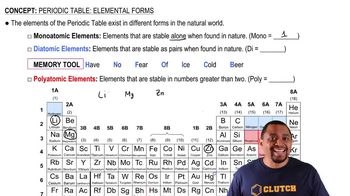Here are the essential concepts you must grasp in order to answer the question correctly.
Electron Affinity
Electron affinity is the energy change that occurs when an electron is added to a neutral atom in the gas phase. A more negative electron affinity indicates a greater release of energy, meaning the atom more readily accepts an electron. This property is crucial for understanding how elements interact with electrons and form negative ions.
Recommended video:
Periodic Trends
Periodic trends refer to the predictable patterns observed in the properties of elements across the periodic table. For electron affinity, elements on the right side of the table (like halogens) generally have more negative values compared to those on the left (like alkaline earth metals). Understanding these trends helps in predicting the behavior of elements in terms of their electron affinity.
Recommended video:
Comparison of Elements
When comparing elements for their electron affinity, it is essential to consider their atomic structure, including the number of valence electrons and their effective nuclear charge. Elements with higher effective nuclear charge tend to have more negative electron affinities because they can attract additional electrons more effectively. This comparison is key to determining which element in each pair has a more exothermic electron affinity.
Recommended video:
Elemental Forms of Elements





